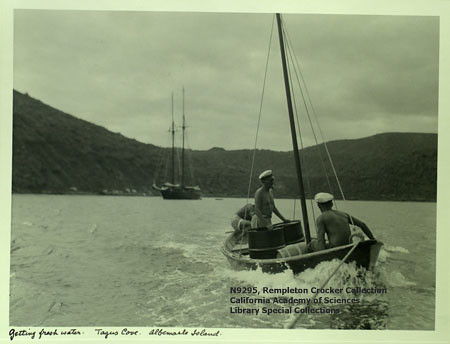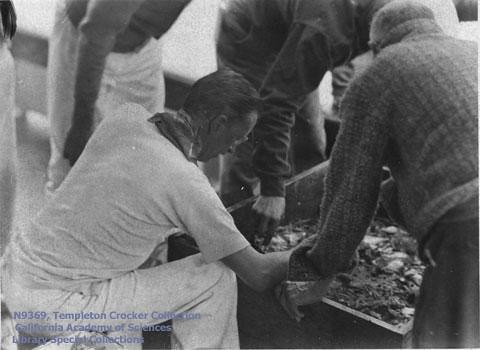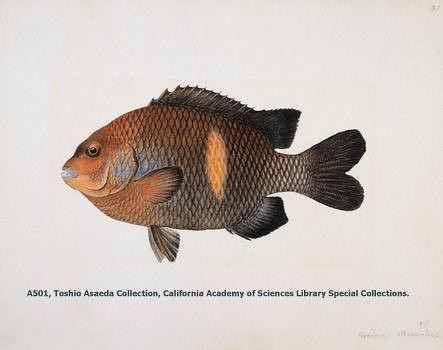1932 Templeton Crocker Expedition of the California Academy of Sciences to Mexico and the Galapagos
Last Friday night, the Academy celebrated one year in its new building with the Big Bang Gala. The Library and Archive staff was on hand, and we set up a table to display highlights from the 1932 C. Templeton Crocker Expedition of the California Academy of Sciences to Mexico and the Galapagos.

Getting fresh water, Tagus Cove. Zaca in the background.
Charles Templeton Crocker (1884-1948) a self proclaimed explorer, sailed his yacht the Zaca around the world, covering 27, 152 miles and visiting 50 ports. He made an expedition to the Galapagos Islands for the California Academy of Sciences (March 1932 – September 1932). A 2,690 foot mountain on Indefatigable Island was named Mount Crocker in honor of his conquest of that peak. Later expeditions included Honolulu, Hawaii with the Bishop Museum (1933), Easter Island for the American Museum of Natural History (1934), Gulf of California for the New York Zoological Society (1936), Hawaii, Tongareva and Samoa for American Museum of Natural History (1936-1937). Crocker received the Ribbon of the Legion of Honor (France, 1926) for his opera “Fei-Yen-Fah”, an adaptation of a play he had written, “Land of Happiness”. He also authored The Cruise of the Zaca in 1933.

Crocker and H. Walton Clark inspecting specimens
Toshio Asaeda worked for Templeton Crocker as a photographer and artist from 1932-1938. On the 1932 expedition, Asaeda painted over three hundred water colors of fishes, crabs and marine life (featured below) and took over 1400 photographs. While Asaeda's illustrations are beautiful works of art they are also significant scientific documents. Asaeda captured the natural color of the animals by painting them right after they were pulled from the water. In a time before color photography was a practical endeavor, this was the best way to capture the actual coloration of specimens. Once animals are preserved in alcohol or formalin their natural color fades and although dark markings like spots and stripes can remain, scientific illustrations are the main document of these animals' colors in the wild.

Brachyura (true crabs). A. Xanthidae; cf. Panopeus sp. from Magalena Bay, Mexico collected August 10, 1932. B. Mursia gaudichaudii (valid name Platymera gaudichaudii H. Milne Edwards, 1837). Collected August 19, 1932 San Martin Island, Mexico.
Toshio Asaeda (1893-1968) came to the United States from Tokyo as a student. In 1924, Asaeda accepted a job at the James L. Clark Studios in New York. Clark was in charge of taxidermy and exhibit preparation for the American Museum of Natural History. From 1925 to 1927, Asaeda lived in San Francisco; it was during this time that he began his forty-year relationship with the California Academy of Sciences. His initial position was as an artist for the Ichthyology Department.
In 1940, Asaeda opened his own photography studio on Grant Avenue in downtown San Francisco. This business venture ended in 1942, when Asaeda and his wife, Suzuka, were sent to an internment camp in Topaz, Utah. At the internment camp, Asaeda taught United States geography and stone polishing to adult internees.
After the war and his release from internment, Asaeda took a job preparing, drawing, and photographing fossils at the California Institute of Technology in Pasadena, California. In 1949, Asaeda accepted a position at the Academy as Assistant Curator in the Department of Exhibits, a job which allowed him to use his considerable artistic and technical skills. Asaeda retired in 1965 to begin work on his garden. He died on March 18, 1968.
Additional Asaeda watercolors are featured in the Academy's Islands of Evolution exhibit on the main floor.

Carides; Crago sp. (shrimp). Collected Cedros Island, Mexico on August 18, 1932. 8" x 10" plate.

Nexilosus albermarleus (Damselfish) Tagus Cove, Albermarle Island, Galapagos. Collected May 26, 1932. Valid name Nexilosus latifrons (Tschudi, 1846).
- Danielle Castronovo, Archives and Digital Collections Librarian
* Crocker and Asaeda's biographical information was taken from departmental finding aids.
* Dave Catania from Ichthyology supplied information on specimen preparation.